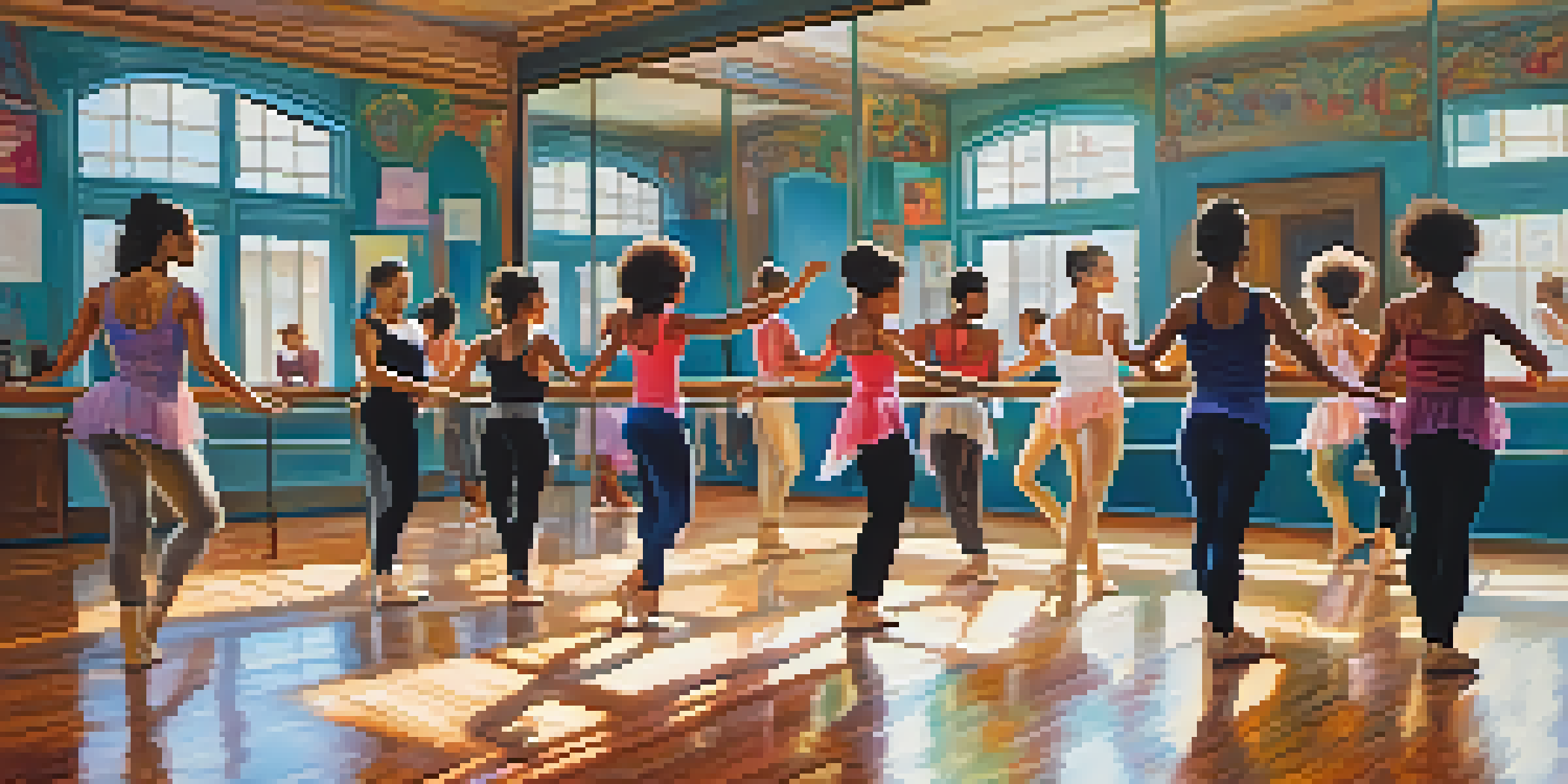The Science Behind Dance: Neuroplasticity and Movement

Understanding Neuroplasticity: The Brain's Adaptability
Neuroplasticity is the brain's remarkable ability to reorganize itself by forming new neural connections throughout life. This means that our experiences, including learning and movement, can physically change our brain structure. For instance, when you learn a new dance routine, your brain is not just memorizing steps; it's actually altering its pathways to accommodate this new information.
Dance is the hidden language of the soul.
This adaptability is essential for growth and recovery, particularly after injuries or learning new skills. In the context of dance, as you practice, your brain becomes better at coordinating movements and responding to music. Over time, these improvements can lead to enhanced cognitive function, emotional regulation, and even social skills, proving that dance is more than just a physical activity.
Moreover, neuroplasticity emphasizes the importance of lifelong learning. Engaging in dance, regardless of age, can stimulate brain activity and promote mental health. Whether you're a seasoned dancer or just starting out, each movement contributes to your brain's ongoing development and resilience.
Dance and the Brain: How Movement Sparks Change
When we dance, our brains are activated in unique ways, engaging various regions responsible for movement, emotion, and cognition. The rhythm and coordination required in dance stimulate neural networks, fostering connections that enhance memory and learning. For example, dancers often display improved spatial awareness and reaction times, showcasing the brain's ability to adapt to physical demands.

Additionally, the joy of dancing releases neurotransmitters like dopamine, which boosts mood and motivation. This creates a positive feedback loop: the more we dance, the better we feel, and the more our brains benefit from this activity. It's a beautiful cycle that underscores the link between physical movement and emotional well-being.
Neuroplasticity Enhances Learning
Engaging in activities like dance physically alters brain pathways, improving cognitive functions and memory.
Research indicates that even simple dance movements can lead to significant cognitive benefits. In one study, older adults who engaged in regular dance classes showed improved memory and mental agility compared to those who did not. This highlights the power of dance as a tool for brain health, making it an enjoyable way to keep our minds sharp.
The Role of Dance in Emotional Expression and Healing
Dance is a universal language of expression that transcends cultural boundaries, allowing individuals to convey emotions in ways words often cannot. This expressive quality plays a vital role in emotional healing and self-discovery. When we move, we tap into feelings that might be difficult to articulate, helping to release pent-up emotions and foster a sense of catharsis.
The body says what words cannot.
Therapeutic practices like dance/movement therapy leverage this connection between emotion and movement to aid individuals in processing trauma and improving mental health. Clients are encouraged to express their feelings through dance, promoting a deeper understanding of their emotional state. This therapeutic approach highlights how dance can be a powerful tool for personal growth and healing.
Moreover, engaging in dance can boost self-esteem and body confidence. As individuals learn to appreciate their bodies through movement, they often develop a more positive self-image. This newfound confidence can spill over into other areas of life, enhancing social interactions and overall well-being.
Learning New Dance Styles: A Workout for the Brain
Learning a new dance style, whether it's salsa, ballet, or hip-hop, is akin to a workout for both the body and brain. Each genre comes with its own set of techniques, rhythms, and steps, challenging our cognitive abilities and motor skills. As we navigate these new movements, our brains are busy forming new connections and pathways, enhancing our neuroplasticity.
For instance, mastering the intricate footwork of a tango not only requires physical practice but also sharpens our focus and memory. This dual engagement of mind and body reinforces the idea that dance is an effective way to keep our brains active and healthy. The more we challenge ourselves with different styles, the more adaptable our brains become.
Dance Boosts Emotional Health
Dance serves as a powerful form of emotional expression, promoting healing and self-discovery through movement.
Additionally, the social aspect of learning dance styles fosters community and connection. Group classes provide opportunities for social interaction, collaboration, and support, which can further enhance the brain's adaptability. By dancing together, we not only learn from one another but also strengthen our social bonds, enriching our overall experience.
Dance and Memory: The Connection to Learning
Dance has a unique relationship with memory, as it often involves memorizing sequences and patterns. This process activates various brain regions, particularly those involved in spatial awareness and motor control. Engaging in regular dance practice can significantly improve both short-term and long-term memory, making it an effective tool for learning.
For example, studies have shown that dancers often outperform non-dancers in tasks requiring memory recall. This connection between dance and memory can be attributed to the brain's ability to create associations between movements and music, reinforcing learning through repetition and rhythm. It's fascinating how our bodies can serve as vessels for memory retention.
Moreover, the rhythmic aspect of dance can enhance cognitive processing. The beat and tempo provide a structured framework that helps in organizing information, making it easier to remember complex sequences. As we dance, we're not just moving; we're engaging our minds in a dynamic and creative way that promotes overall cognitive health.
Dance and Physical Health: A Holistic Approach
The benefits of dance extend beyond the brain to encompass physical health as well. Regular dancing improves cardiovascular fitness, flexibility, and muscle strength, contributing to a holistic approach to well-being. As we engage in dance, our bodies release endorphins, which elevate mood and reduce stress, creating a positive feedback loop that promotes both physical and mental health.
Moreover, dance can provide a low-impact alternative to traditional exercise routines, making it accessible to people of all ages and abilities. Whether you're dancing in a studio or at home, the movement can be tailored to your fitness level, ensuring everyone can enjoy its benefits. This inclusivity makes dance an ideal form of exercise for maintaining overall health.
Physical Activity Supports Well-Being
Regular dancing not only improves physical health but also fosters social connections, enhancing overall well-being.
Additionally, participating in dance classes fosters a sense of belonging and community, which is vital for emotional health. The social connections formed through dance can lead to lasting friendships, reducing feelings of isolation and loneliness. Ultimately, dance not only strengthens our bodies but also enriches our social lives, making it a valuable pursuit for overall well-being.
Embracing Dance as a Lifelong Practice
Embracing dance as a lifelong practice can lead to profound benefits for our brains, bodies, and spirits. Regardless of when you start, incorporating dance into your routine can enrich your life in countless ways. It's not just about the steps; it's about the joy, creativity, and connection that dance fosters.
As we age, maintaining an active lifestyle becomes increasingly important for both physical and cognitive health. Dance provides a fun and dynamic way to stay engaged and challenged, helping to stave off the mental decline that can accompany aging. The beauty of dance lies in its adaptability; there is always something new to learn or explore.

Ultimately, dance invites us to express ourselves, connect with others, and keep our minds and bodies agile. By making dance a part of our lives, we can harness its transformative power to enhance our well-being and embrace the joy of movement, no matter our age or skill level.